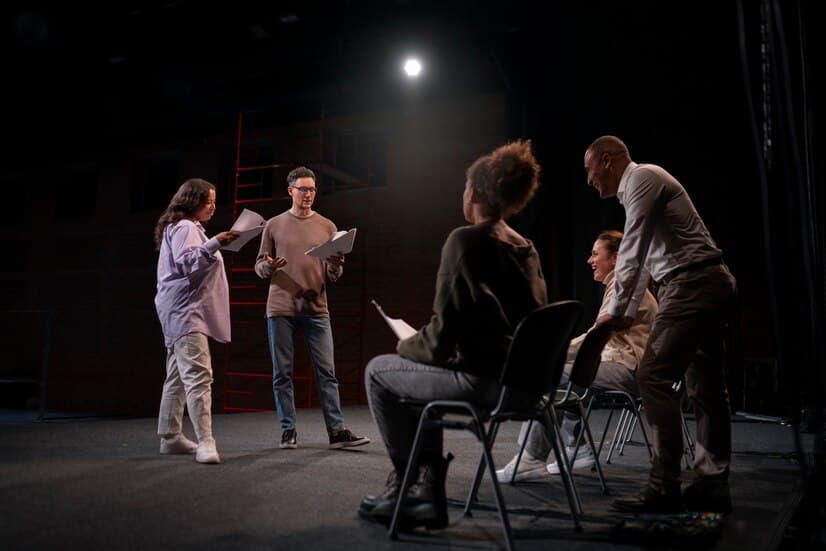Viewpoints acting revolutionizes the conventional approach to character development by emphasizing observation and movement over psychological analysis. Unlike traditional methods that delve into understanding characters’ inner motivations, Viewpoints encourages actors to explore the interplay of space, shape, time, and emotion on stage.
Exploring the Roots of Viewpoints
The inception of Viewpoints acting can be traced back to Mary Overlie, a visionary choreographer who introduced six fundamental elements of onstage performance.
These elements, comprising space, shape, time, emotion, movement, and story, lay the groundwork for the Viewpoints method.
Comprehensive Understanding of the Viewpoints Method
Expanding the Horizons:
- Spatial Dynamics;
- Kinesthetic Awareness;
- Form and Configuration;
- Expressive Gestures;
- Iterative Patterns;
- Architectural Influence;
- Rhythmic Pacing;
- Temporal Duration;
- Terrain Exploration.
Vocal Perspectives:
- Pitch Variations;
- Dynamic Intensity;
- Speed Modulations;
- Pauses and Silence;
- Timbral Nuances.
Distinguishing Characteristics of Viewpoints
Viewpoints acting diverges from traditional naturalistic approaches by prioritizing observation and dynamic movement. Rather than focusing solely on psychological realism, actors engage in collaborative exploration, offering multifaceted perspectives to theatrical moments.
Effective Strategies for Implementing Viewpoints:
- Observational Immersion: Immerse yourself in the surroundings, drawing inspiration from the nuances of everyday life;
- Collaborative Endeavors: Foster a spirit of collaboration within the ensemble, enriching understanding and connectivity;
- Embodied Expression: Harness the power of physicality to convey emotions and narratives authentically;
- Embracing Serendipity: Embrace spontaneity and welcome unforeseen discoveries, infusing performances with vibrancy and unpredictability.
Benefits of Viewpoints Acting
Viewpoints acting offers numerous benefits to actors, enriching their craft and expanding their artistic horizons.
Some specific advantages include:
- Versatility: By embracing the principles of observation and movement, actors become more versatile performers capable of adapting to a wide range of roles and styles;
- Creativity: Viewpoints acting encourages creative exploration and experimentation, fostering innovation and originality in performances;
- Authenticity: By prioritizing physicality and collaboration, actors can achieve a deeper sense of authenticity in their portrayals, connecting more profoundly with audiences;
- Adaptability: The skills developed through Viewpoints acting are transferable to various performance contexts, including stage, film, television, and even digital media, enhancing actors’ adaptability in an ever-evolving industry.
Applications in Modern Theatre
Contemporary theater companies are increasingly integrating Viewpoints into their rehearsal processes to enhance the quality and impact of their productions. Here are some specific applications:
- Devising Theater: Viewpoints provide a fertile ground for devising original theatrical works, allowing ensembles to collaboratively explore themes, characters, and narratives through movement and improvisation;
- Physical Theater: Viewpoints techniques are particularly well-suited for physical theater productions, where performers rely heavily on non-verbal communication and expressive movement to convey meaning;
- Experimental Theater: Viewpoints acting lends itself to experimental and avant-garde theater, where artists seek to challenge traditional conventions and push the boundaries of performance;
- Site-Specific Performances: Viewpoints principles can be applied to site-specific performances, where actors interact with unconventional spaces and environments, creating immersive and unforgettable theatrical experiences.
Viewpoints in Film and Television
While Viewpoints acting is traditionally associated with live theater, its principles can also be applied effectively in film and television productions.
Here’s how:
- Character Development: Actors can use Viewpoints techniques to deepen their understanding of their characters, incorporating physicality and spatial awareness into their on-screen performances;
- Blocking and Choreography: Directors and choreographers can utilize Viewpoints principles to create dynamic and visually compelling blocking and choreography sequences, enhancing the overall visual aesthetic of a film or television show;
- Ensemble Dynamics: Viewpoints fosters a spirit of collaboration and ensemble work, which can translate seamlessly to film and television sets, promoting cohesion and synergy among cast and crew members;
- Authenticity in Action: Viewpoints encourage actors to embody characters with authenticity and presence, resulting in more compelling and believable performances on screen.
Conclusion
Viewpoints acting offers a dynamic pathway for actors to unlock their creative potential and deepen their understanding of the theatrical craft. By embracing observation, movement, and collaboration, performers can transcend traditional boundaries, paving the way for transformative and authentic experiences on stage and beyond.
